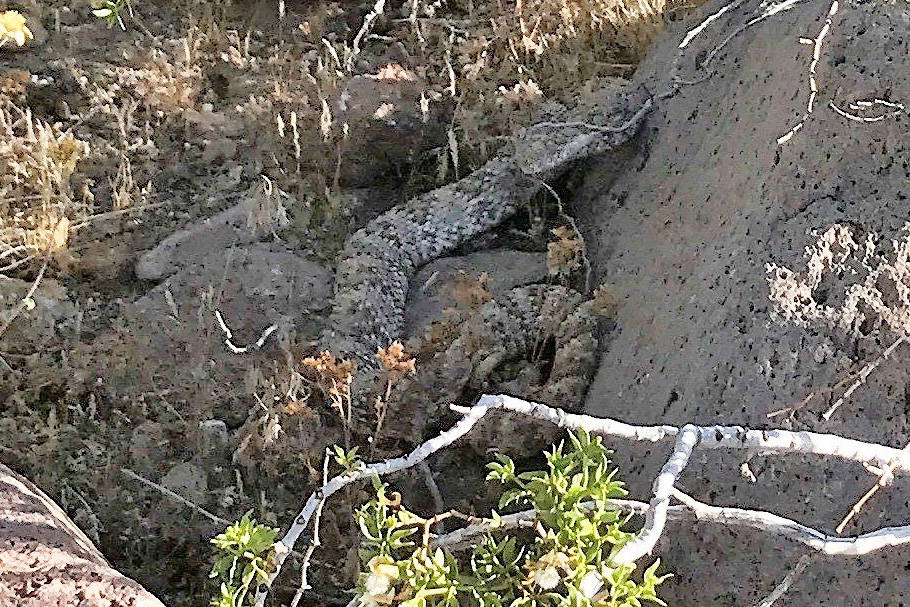Keep eyes open for rattlesnakes hiding in plain sight

According to the Merriam-Webster Dictionary, camouflage is defined as “concealment by means of disguise” or “behavior … designed to deceive or hide.” But if one pays attention to his outdoor surroundings, Mother Nature will show you the most effective camouflage is a combination of the two.
Despite all the money spent on developing new and improved camouflage patterns for public consumption, I am not so sure we will ever match what nature provides, let alone improve on it.
I was reminded of this recently while hiking one of the trails that leads into the hills on the edge of town. Like many of the local trails, this one winds its way through a variety of habitats ranging from sandy wash bottoms to steep cliff faces and boulder-strewn hillsides. It was early in the morning, so critters were out and about.
Along the way I encountered rabbits, quail, songbirds and multiple lizard species. Among them, the largest desert iguana I have ever seen. Most of these animals blended in with the environment so well that I would not have seen them if they had not moved. They forgot about the behavior designed to deceive or hide.
The irony is that the iguana only froze in place once he knew he was caught in the open. By then, however, it was too late. Had he stayed put in the first place, I probably would have walked right past him. Sometimes when we are hunting, we move too much and give ourselves away to the game we seek. Something to keep in mind next time you go afield.
Since the country through which the trail passes is superb snake habitat, I fully expected to encounter one somewhere along the way. As you might expect, I was keeping a sharp lookout for anything that resembled a snake, especially the rattling variety.
Testing the trail ahead with my trekking poles — in case something wriggly was hiding behind a rock or under a bush — I moved along at a good clip. Well, a good clip for me. My pride was hurt when a lady that appeared to be in her early 60s easily ran past me and disappeared where the trail forks.
When temperatures push toward the century mark, rattlesnakes will bask in the early morning sun to raise their body temperature. You can sometimes see them coiled on top of a rock or rocky outcropping. Then when it begins to get too warm, they head for shade. Not unlike us. So, when you feel the need to find a shady spot, they will too. That is why it is always a good idea to look before you sit.
As I neared the turnaround spot, I focused my attention on two holes in the hillside along the trail and thought, “Those look like a likely spot for a snake to hole up.” And that is when I heard the unmistakable sound of a rattlesnake’s rattle. I stopped right there and sought out its source before taking another step.
To my surprise, the snake was behind me and off to one side of the trail. Despite what I thought to be an intense focus on my surroundings, I had walked right past a speckled rattlesnake that had probably been dosing along the trail. He had given me only a quick buzz of warning and was headed for cover when I picked him out. His natural camouflage had done what it was intended to do. He blended in with his surroundings, until he moved. One has to wonder how many other snakes I already had walked past that morning.
My new friend was not hanging around to see whether I intended to do it harm; his response to my presence was to give me a brief warning and then retreat to the safety of cover. While people are bitten by rattlesnakes every year, most bites occur when people do not leave the snake alone. If you give them a wide berth, they will do the same for you.
Rattlesnakes are most active from March through October. In the spring they are active throughout the day, but once temperatures become hot, they shift their activity to the nighttime hours. If you enjoy evening walks, it is a good idea to carry a flashlight.
Freelance writer Doug Nielsen is a conservation educator for the Nevada Department of Wildlife. His “In the Outdoors” column is not affiliated with or endorsed by the NDOW. Any opinions are his own. Find him on Facebook at @dougwritesoutdoors. He can be reached at intheoutdoorslv@gmail.com.